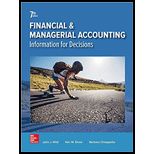
Concept explainers
The evaluation or estimation of monetary worth of inventory bought in order to ascertain the cost of goods sold is termed as inventory valuation or inventory costing. Inventory valuation helps to ascertain the cost of goods sold and the cost of closing inventory.
There are majorly four methods used for costing of inventory:
- First in, first out method;
- Last in, first out method
- Weighted average costing method
- Specific identification method.
First in, first out method:
In first in first out method, also known as FIFO method, the inventory which was bought first will be the first one to be taken out.
Last in, first out method:
In case of last in, first out, also known as LIFO method, the inventory which was bought in the last will be taken out first.
Weighted average cost method:
In this method the weighted average cost is evaluated after any purchases have been made and transactions are recorded as when purchase or sales take place.
Specific identification method:
Under this method, a continuous track of the inventory needs to be maintained and the inventory cost is evaluated at the time of purchase, on the basis of unique identity which also helps in the valuation of the ending inventory as well as the cost of goods sold. This method is generally used when the company is involved in limited expensive goods which are easily identifiable.
To Identify: The inventory costing method which best to describe the given statements.
1.
Want to see the full answer?
Check out a sample textbook solution
Chapter 5 Solutions
GEN COMBO FINANCIAL AND MANAGERIAL ACCOUNTING; CONNECT ACCESS CARD
- Describe how inventory is valued under FIFO and LIFO methods. Explain.arrow_forwardPlease explain the solution to this general accounting problem with accurate principles.arrow_forwardCarrington Trading is a merchandising company. Last month, the company's cost of goods sold was $72,800. The company's beginning merchandise inventory was $24,500, and its ending merchandise inventory was $21,300. What was the total amount of the company's merchandise purchases for the month?arrow_forward
- I need guidance with this general accounting problem using the right accounting principles.arrow_forwardHow is the cost of goods sold (COGS) calculated? Explanation.arrow_forwardDie Industries began operations on March 1 with cash of $150,000. All of March's $240,000 sales were on account. During March, no customer collections occurred. The cost of goods sold was $95,000, and there were no ending inventories or accounts payable. Use this information to determine the ending balance of cash on hand for March.arrow_forward

 AccountingAccountingISBN:9781337272094Author:WARREN, Carl S., Reeve, James M., Duchac, Jonathan E.Publisher:Cengage Learning,
AccountingAccountingISBN:9781337272094Author:WARREN, Carl S., Reeve, James M., Duchac, Jonathan E.Publisher:Cengage Learning, Accounting Information SystemsAccountingISBN:9781337619202Author:Hall, James A.Publisher:Cengage Learning,
Accounting Information SystemsAccountingISBN:9781337619202Author:Hall, James A.Publisher:Cengage Learning, Horngren's Cost Accounting: A Managerial Emphasis...AccountingISBN:9780134475585Author:Srikant M. Datar, Madhav V. RajanPublisher:PEARSON
Horngren's Cost Accounting: A Managerial Emphasis...AccountingISBN:9780134475585Author:Srikant M. Datar, Madhav V. RajanPublisher:PEARSON Intermediate AccountingAccountingISBN:9781259722660Author:J. David Spiceland, Mark W. Nelson, Wayne M ThomasPublisher:McGraw-Hill Education
Intermediate AccountingAccountingISBN:9781259722660Author:J. David Spiceland, Mark W. Nelson, Wayne M ThomasPublisher:McGraw-Hill Education Financial and Managerial AccountingAccountingISBN:9781259726705Author:John J Wild, Ken W. Shaw, Barbara Chiappetta Fundamental Accounting PrinciplesPublisher:McGraw-Hill Education
Financial and Managerial AccountingAccountingISBN:9781259726705Author:John J Wild, Ken W. Shaw, Barbara Chiappetta Fundamental Accounting PrinciplesPublisher:McGraw-Hill Education





